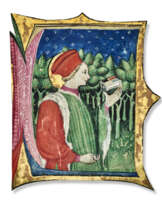ID 794499
Lot 10 | Frate Nebridio (active 1460s-1490s)
Estimate value
£ 15 000 – 20 000
The Last Supper, historiated initial from an Antiphonal, illuminated manuscript on vellum [Lombardy, probably Cremona, c.1470s]
An imposing Last Supper painted by the Lombard illuminator Frate Nebridio, a Dominican monk known to have worked on the splendid corali made for Cremona cathedral.
182 x 155mm. Historiated initial ‘Z’ with the Last Supper, presumably opening the Mass of the Lord's Supper on Holy Thursday 'Zelus domus tue comedit me [...]', verso with two lines of text and music on a four-line stave (small instance of pigment flaking, the gold slightly rubbed). Laid down onto card mount (245 x 225mm). Framed.
The Dominican monk Frate Nebridio was one of the illuminators employed to complete a grand series of choirbooks for the duomo of Cremona in the second half of the 15th century, as well as contributing work to manuscripts painted for other religious houses in Lombardy and for lay patrons (for an overview of Nebridio’s career, see P. Palladino, Treasures of a Lost Art, 2003, pp.129-131; for a more detailed discussion of Nebridio’s stylistic evolution and his identity, see M. Faraoni, ‘Frate Nebridio Miniatore e Un Inedito Codice Lodigiano’, Arte Lombarda, no 167 (1), 2013, pp. 106–09). Nebridio’s identity is known from two signed works: an initial ‘E’ with a figure of St Augustine (Bologna, Museo Civico, Coll. Pal. No. 673) and a historiated initial depicting the Resurrection (Cambridge, MA, Harvard, MS Typ 979, seq. 9), one of a group of initials held at the Houghton Library, from which others have also been attributed to the artist. Nebridio’s hand first appears in manuscripts painted in the 1460s – he collaborated with other artists on a copy of Sallust’s Bellum Jugurtinum and Bellum Catilinarium (Paris, BnF, Lat. 18272) and a Breviary for the convent of San Domenico in Cremona, both completed in 1467 – and he was active until at least the mid-1490s; in 1503, in a payment made to his nephew Marchino for the illumination of a Gradual, Nebridio is referred to as deceased. His style is characterised by soft, curling strokes to define hair and beards, long, thin hands, round-eyed faces and small mouths; as he moved towards his artistic maturity, his works begin to display more sophisticated architectural settings.
Special notice
This lot has been imported from outside of the UK for sale and placed under the Temporary Admission regime. Import VAT is payable at 5% on the hammer price. VAT at 20% will be added to the buyer’s premium but will not be shown separately on our invoice.
| Place of origin: | Italy, Europe |
|---|---|
| Auction house category: | Medieval & renaissance manuscripts |
| Place of origin: | Italy, Europe |
|---|---|
| Auction house category: | Medieval & renaissance manuscripts |
| Address of auction |
CHRISTIE'S 8 King Street, St. James's SW1Y 6QT London United Kingdom | |
|---|---|---|
| Preview |
| |
| Phone | +44 (0)20 7839 9060 | |
| Buyer Premium | see on Website | |
| Conditions of purchase | Conditions of purchase |





